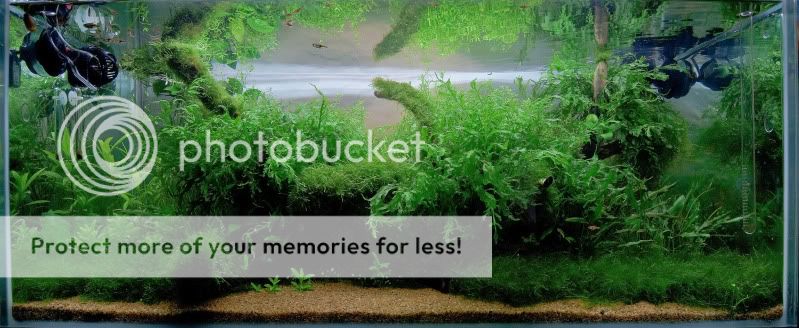waterdrop
Enthusiastic "Re-Beginner"
Now that lljdma06 has sent you guys out to pasture in the PARC and Dave has got the plants doing the cycling for you I thought it only fitting that I, as "beginner who talks too much" should attempt to pose another truly difficult question to draw the experts out of retirement and probably cause a huge sigh with nothing penned...
So here goes: I've read umpteen million articles on having light that's shining down at this or that energy, focused better with this or that reflector and kept on for this or that many hours, adjusted in this or that way to balance plant growth with algae avoidance, but its not good enough, I hunger for more!
What is the nature of the light problem in freshwater planted tanks? I know we all struggle with our own trial and error on this question but... How does the successful planted tankmaster *think* about his/her light? Which tradeoffs are more important than others? I'm just hoping to encourage you to share your insights, things that surprised you perhaps.. but I'll try to start that off by somehow shaping a few of my simple-minded questions.
What got me really thinking about light this time was realizing I'd gone over a year without changing out my fluorescents for new tubes. Lots of posts saying to do this. But then I thought, ok, they're dimming a tiny bit (not that I can see but the time is supposed to do that to them) but... and here is The Question... What is the difference, to plants, between more brightness (more photons per minute I'd guess/say) (in whatever wavelengths, lets leave that out) vs. more or less hours per day?
I found myself thinking about these 3 things, the tube somehow being different from age, the "energy" (for lack of a better term, since none of the light measurment things seem to work out as a useful scale) and the hours. I just can't get this out of my head, wondering about the brighter, fresher new fluorescent bulb vs the older dimmer one.
The hours have some interesting tidbits people mention. There's a statement people make that any photoperiod less than 4 hours won't be "seen" by the plant. That sounds interesting and I've even repeated it to others but I don't pretend to really understand that, any help? There are older statements by Dave and others here I respect who discuss starting out new tanks at maybe only 4 hours and then gradually increasing hours, watching for algae. I'm always interested in hearing peoples thoughts on that. There seem to be lots of people that will just declare that you need at least 9, 10, 11, 12 hours of light for healthy plants.. but that seems to cry out for more discussion.
WD
So here goes: I've read umpteen million articles on having light that's shining down at this or that energy, focused better with this or that reflector and kept on for this or that many hours, adjusted in this or that way to balance plant growth with algae avoidance, but its not good enough, I hunger for more!
What is the nature of the light problem in freshwater planted tanks? I know we all struggle with our own trial and error on this question but... How does the successful planted tankmaster *think* about his/her light? Which tradeoffs are more important than others? I'm just hoping to encourage you to share your insights, things that surprised you perhaps.. but I'll try to start that off by somehow shaping a few of my simple-minded questions.
What got me really thinking about light this time was realizing I'd gone over a year without changing out my fluorescents for new tubes. Lots of posts saying to do this. But then I thought, ok, they're dimming a tiny bit (not that I can see but the time is supposed to do that to them) but... and here is The Question... What is the difference, to plants, between more brightness (more photons per minute I'd guess/say) (in whatever wavelengths, lets leave that out) vs. more or less hours per day?
I found myself thinking about these 3 things, the tube somehow being different from age, the "energy" (for lack of a better term, since none of the light measurment things seem to work out as a useful scale) and the hours. I just can't get this out of my head, wondering about the brighter, fresher new fluorescent bulb vs the older dimmer one.
The hours have some interesting tidbits people mention. There's a statement people make that any photoperiod less than 4 hours won't be "seen" by the plant. That sounds interesting and I've even repeated it to others but I don't pretend to really understand that, any help? There are older statements by Dave and others here I respect who discuss starting out new tanks at maybe only 4 hours and then gradually increasing hours, watching for algae. I'm always interested in hearing peoples thoughts on that. There seem to be lots of people that will just declare that you need at least 9, 10, 11, 12 hours of light for healthy plants.. but that seems to cry out for more discussion.
WD


 Don't hold your breath. I went into this figuring it might take a month before Dave and Aaron notice it, so I'll have to be innovative, making up reasons to bump it back up, lol. WD
Don't hold your breath. I went into this figuring it might take a month before Dave and Aaron notice it, so I'll have to be innovative, making up reasons to bump it back up, lol. WD
 /www.plantedtank.net/forums/planted-nano-tanks/95967-official-edge-thread.html
/www.plantedtank.net/forums/planted-nano-tanks/95967-official-edge-thread.html